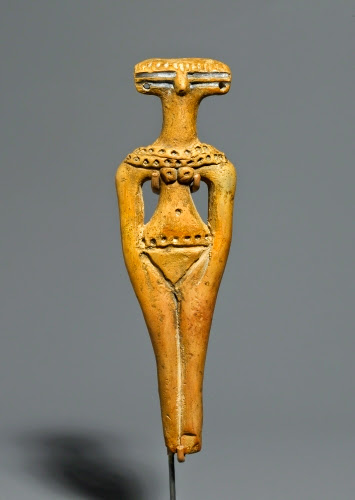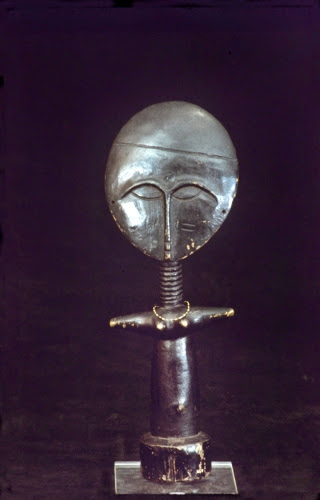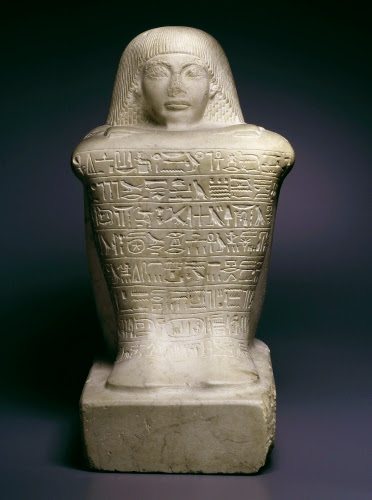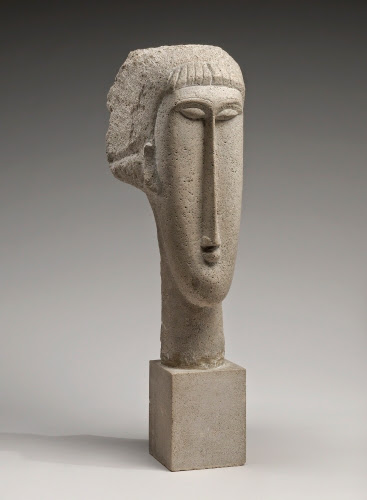Abstraction is Nothing New: Ancient Egypt
I’m making a declaration: artists were inspired to create abstract art thousands of years ago. When one (and by “one” I mean a person reading an art history text) reads about any art that pre-dates the early 1900s that shows extreme simplification, the author inevitably says that it “has an almost abstract” quality. Then there are the other words usually paired with abstract ancient art: extreme simplification, stylization, idealization, conceptualization, etc.
 |
| Ancient Egypt, Figurine of a Woman, ca. 1696–1539 BCE. Terra cotta, 4 11/16" x 1 7/16 x 1/2" (12 x 3.7 x 1.5 cm). © Brooklyn Museum. (BMA-5018) |
Two of the most basic definitions of abstraction are “the reduction of forms to their simplest state”(simplification) and “an artwork that does not represent objects of the observed physical world” (stylization). I propose that the study of ancient cultures now include such subjects as “The Abstract Wing of The Second Intermediate Period in Ancient Egypt.”
Going all the way back to the earliest dynasties of the Old Kingdom in Egypt (ca. 2650–2184 BCE), the realistic depiction of human beings and animals is readily evident. Naturally, the realism was softened when depicting rulers or members of the nobility so that they looked like fresh, young, perfect human beings. For more humble officials and their families, the realism was often more spot on. Even in the hyper realism, though, there is a stiffness and simplification of forms that could “hint at abstraction.” This may be partially because of the block-like, rigid formality of the pose of the figures, a convention that lasted almost 3000 years in Egyptian art.
This figurine dates from the Second Intermediate Period in Egypt, ca 1696–1539 BCE. This was a chaotic period when the Hyksos, a Semitic people from the east, invaded and occupied northern Egypt. They ruled as the Fifteenth Dynasty, while Egyptian princes of the Thirteenth, Sixteenth and Seventeenth ruled southern Egypt from Thebes. Kamose (reigned ca. early 1540s BCE), the pharaoh in Thebes began a rebellion that eventually led to the destruction of the Hyksos dynasty. His brother Ahmose (reigned ca. 1539–1514 BCE) restored a united Egypt under Dynasty Eighteen.
The purpose of this figurine is not known, although it bears similarities to pre-dynastic female and male figures that are extremely simplified excepting, the details of their anatomically specific parts. Compared to the realism of funerary sculpture of this period, this is refreshingly original. Various theories explain this figurine as Nubian (Kushite), the Upper Nile culture, or simply the product of an “unofficial” artist who was not following the accepted artistic conventions.
It reminds me of the abstract Akua ‘Ba figures from the Asante culture (traditionally matriarchal) in Ghana that were traditionally carried by girls to help teach them about motherhood, and by pregnant women to ensure a healthy birth. The Akua’Ba are marvelous abstract summations of some of the traditionally held ideals of feminine beauty.
 |
| Asante People, Ghana, Akua’Ba, 1900s. Wood, height: 13 3/8" (34 cm). Private Collection. Image © Davis Art Images. (8S-10517) |
Here are a couple more examples of ancient Egyptian abstraction. I really like the block expressions of individuals, so similar to the seated scribe genre. And do we see a little Giacometti in the standing male figure?
 |
| Ancient Egypt, Block Statue of Ay, ca. 1327–1323 BCE. Limestone, 18 1/2" x 10 x 12 3/16" (47 x 25 x 31 cm). © Brooklyn Museum. (BMA-570) |
 |
| Ancient Egypt, Figurine of a Man, ca. 1986–1759 BCE. Copper, 5" x 1 1/2" x 1" (12.7 x 3.81 x 2.54 cm). © Albright-Knox Art Gallery, Buffalo, NY. (AK-1003) |
And here is a 20th century artist who was there when they “invented” abstraction in the early 1900s. I wonder which inspired him more: ancient art or “primitive” art?
 |
| Amedeo Modigliani (1884–1920, Italy), Head of a Woman, 1910/1911. Limestone, 25 5/8" x 7 1/2" x 9 3/4" (65.2 x 19 x 24.8 cm). © National Gallery of Art, Washington, DC. (NGA-S0080) |
Correlations to Davis programs: Explorations in Art Grade 6: 1.4; A Community Connection: 3.2; A Global Pursuit: 1.4; Beginning Sculpture: 2; Experience Clay: 3; Exploring Visual Design: 10; The Visual Experience: 10.2, 15.3; Discovering Art History: 5.3


Comments